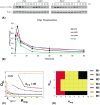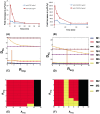In silico modeling of Itk activation kinetics in thymocytes suggests competing positive and negative IP4 mediated feedbacks increase robustness
- PMID: 24066087
- PMCID: PMC3774804
- DOI: 10.1371/journal.pone.0073937
In silico modeling of Itk activation kinetics in thymocytes suggests competing positive and negative IP4 mediated feedbacks increase robustness
Erratum in
- PLoS One. 2014;9(1): 10.1371/annotation/285bb79f-ef1a-467e-9fd3-4e518d65acd3
Abstract
The inositol-phosphate messenger inositol(1,3,4,5)tetrakisphosphate (IP4) is essential for thymocyte positive selection by regulating plasma-membrane association of the protein tyrosine kinase Itk downstream of the T cell receptor (TCR). IP4 can act as a soluble analog of the phosphoinositide 3-kinase (PI3K) membrane lipid product phosphatidylinositol(3,4,5)trisphosphate (PIP3). PIP3 recruits signaling proteins such as Itk to cellular membranes by binding to PH and other domains. In thymocytes, low-dose IP4 binding to the Itk PH domain surprisingly promoted and high-dose IP4 inhibited PIP3 binding of Itk PH domains. However, the mechanisms that underlie the regulation of membrane recruitment of Itk by IP4 and PIP3 remain unclear. The distinct Itk PH domain ability to oligomerize is consistent with a cooperative-allosteric mode of IP4 action. However, other possibilities cannot be ruled out due to difficulties in quantitatively measuring the interactions between Itk, IP4 and PIP3, and in generating non-oligomerizing Itk PH domain mutants. This has hindered a full mechanistic understanding of how IP4 controls Itk function. By combining experimentally measured kinetics of PLCγ1 phosphorylation by Itk with in silico modeling of multiple Itk signaling circuits and a maximum entropy (MaxEnt) based computational approach, we show that those in silico models which are most robust against variations of protein and lipid expression levels and kinetic rates at the single cell level share a cooperative-allosteric mode of Itk regulation by IP4 involving oligomeric Itk PH domains at the plasma membrane. This identifies MaxEnt as an excellent tool for quantifying robustness for complex TCR signaling circuits and provides testable predictions to further elucidate a controversial mechanism of PIP3 signaling.
Conflict of interest statement
Figures




Similar articles
-
Regulation of Hematopoietic Cell Development and Function Through Phosphoinositides.Front Immunol. 2018 May 4;9:931. doi: 10.3389/fimmu.2018.00931. eCollection 2018. Front Immunol. 2018. PMID: 29780388 Free PMC article. Review.
-
Positive regulation of Itk PH domain function by soluble IP4.Science. 2007 May 11;316(5826):886-9. doi: 10.1126/science.1138684. Epub 2007 Apr 5. Science. 2007. PMID: 17412921
-
Evidence that inositol 1,4,5-trisphosphate 3-kinase and inositol 1,3,4,5-tetrakisphosphate are negative regulators of platelet function.Res Pract Thromb Haemost. 2024 Jan 26;8(1):102326. doi: 10.1016/j.rpth.2024.102326. eCollection 2024 Jan. Res Pract Thromb Haemost. 2024. PMID: 38404940 Free PMC article.
-
Phosphoinositide and inositol phosphate analysis in lymphocyte activation.Curr Protoc Immunol. 2009 Nov;Chapter 11:11.1.1-11.1.46. doi: 10.1002/0471142735.im1101s87. Curr Protoc Immunol. 2009. PMID: 19918943 Free PMC article.
-
Lipid and Protein Co-Regulation of PI3K Effectors Akt and Itk in Lymphocytes.Front Immunol. 2015 Mar 13;6:117. doi: 10.3389/fimmu.2015.00117. eCollection 2015. Front Immunol. 2015. PMID: 25821452 Free PMC article. Review.
Cited by
-
In silico modeling identifies CD45 as a regulator of IL-2 synergy in the NKG2D-mediated activation of immature human NK cells.Sci Signal. 2017 Jun 27;10(485):eaai9062. doi: 10.1126/scisignal.aai9062. Sci Signal. 2017. PMID: 28655861 Free PMC article.
-
Regulation of Hematopoietic Cell Development and Function Through Phosphoinositides.Front Immunol. 2018 May 4;9:931. doi: 10.3389/fimmu.2018.00931. eCollection 2018. Front Immunol. 2018. PMID: 29780388 Free PMC article. Review.
-
Modeling the Th17 and Tregs Paradigm: Implications for Cancer Immunotherapy.Front Cell Dev Biol. 2021 May 7;9:675099. doi: 10.3389/fcell.2021.675099. eCollection 2021. Front Cell Dev Biol. 2021. PMID: 34026764 Free PMC article. Review.
-
Severe combined immunodeficiency caused by inositol-trisphosphate 3-kinase B (ITPKB) deficiency.J Allergy Clin Immunol. 2020 Jun;145(6):1696-1699.e6. doi: 10.1016/j.jaci.2020.01.014. Epub 2020 Jan 25. J Allergy Clin Immunol. 2020. PMID: 31987846 Free PMC article. No abstract available.
-
Understanding the Dynamics of T-Cell Activation in Health and Disease Through the Lens of Computational Modeling.JCO Clin Cancer Inform. 2019 Jan;3:1-8. doi: 10.1200/CCI.18.00057. JCO Clin Cancer Inform. 2019. PMID: 30689404 Free PMC article. Review.
References
-
- Irvine RF, Schell MJ (2001) Back in the water: the return of the inositol phosphates. Nature reviews Molecular cell biology 2: 327–338. - PubMed
-
- Huang YH, Grasis JA, Miller AT, Xu R, Soonthornvacharin S, et al. (2007) Positive regulation of Itk PH domain function by soluble IP4. Science 316: 886–889. - PubMed
-
- York JD (2006) Regulation of nuclear processes by inositol polyphosphates. Biochim Biophys Acta 1761: 552–559. - PubMed
Publication types
MeSH terms
Substances
Grants and funding
LinkOut - more resources
Full Text Sources
Other Literature Sources
Molecular Biology Databases

